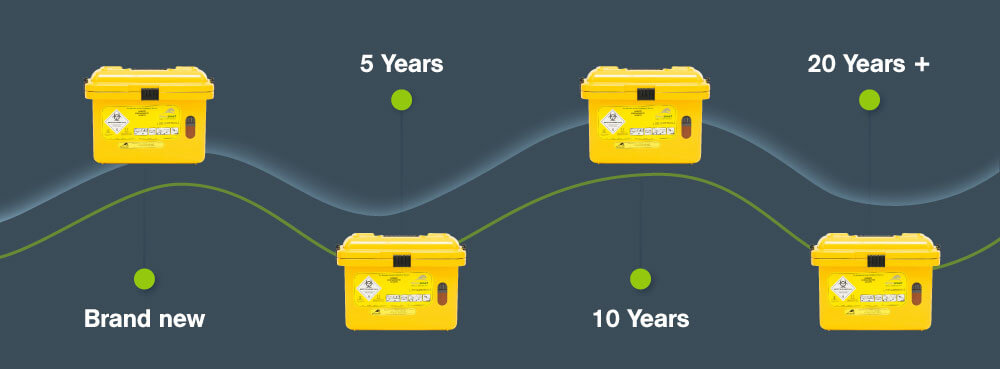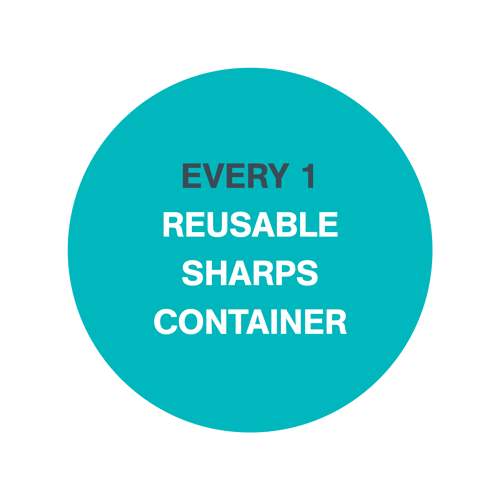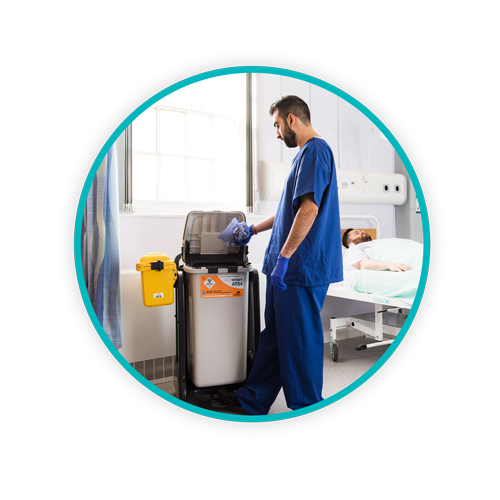The Sustainable Lifecycle of a Reusable Container

As sustainability pioneers in the waste management sector, Sharpsmart has been ahead of the curb for over 35 years with its reusable sharps and clinical waste containers. Our reusable containers are built to last, earning acclaim and recognition in hospitals, primary care and research environments around the globe. Designed with clinical input, Sharpsmart containers not only aid in protecting the health and safety of patients and staff but contribute significantly to the sustainability goals of NHS hospitals and patient care facilities. But what does that look like across the full life cycle of a reusable container?
TOPICS WE WILL COVER:
2 / Whats the difference between using a disposable, recycled, or reusable container collector?
3 / A day in the life of a reusable container
4 / Do Sharpsmart containers increase compliance?
Sharpsmart sustainability – what’s the big deal about reusable containers?
Sustainability is increasingly the name of the game for healthcare waste disposal across all waste streams. When it comes to the environment, our reusable containers contribute significantly to net zero efforts by optimising recycling practices, facilitating resource recovery, reducing the volume of waste (particularly excess plastic) being sent to incineration, and ultimately reducing CO2 emissions through minimised touchpoints and waste treatment requirements.
When you deploy reusable sharps containers in your hospital or healthcare facility, you’re driving a significant sustainability impact by eliminating the manufacturing, purchasing and incineration of single-use plastic sharps containers. In fact, our Sharpsmart container, across its life-cycle, eliminates 788 disposable sharps containers from the healthcare supply chain.
What’s the difference between using a disposable, a recycled, or reusable container collector?
Ultimately disposable containers, along with their contents, are destroyed, meaning a significant and avoidable volume of plastic is being manufactured, transported and incinerated, leading to inflated CO2 emissions burden across its life cycle. Recycled containers while sounding very “green-friendly”, can in fact contain as little as 10% of recycled materials, and cleaning processes require more materials and energy.
In contrast, reusable containers, especially for sharps waste, are constructed for safety and durability, with new global standards providing validation. Think about it like a reusable coffee cup – you simply can’t invest the same durability and robustness in something you sell for a few pennies as a takeaway cup as you would in a ten pound reusable cannister; it’s exactly the same with waste containers. By investing in a reusable design, you don’t get throwaway quality, you get the highest standards of safety features and life cycle durability. In the case of Sharpsmart, all of our reusable sharps containers are hygienically washed and sanitised using our ecological and sustainable Washsmart technology, thereby promoting a dramatic reduction in environmental burden during the washing process.
Across their full life cycle, reusable containers provide significant environmental benefits. Want some stats? In one year alone and in a single facility based in the United States of Amercia, Sharpsmart reusable containers achieved:
- 84% reduction in greenhouse gas (GHG) emissions associated with sharps container usage
- 98% reduction of cardboard weight in landfills
- 99.6% reduction in plastic sent to landfills
- 99.9% reduction in the number of plastic sharps containers landfilled
Utilisation of reusable containers across the NHS and non acute healthcare facilities eliminates the need for manufacturing of an additional 973,000 disposable containers.
A day in the life of a reusable container
A Sharpsmart reusable container has a long lifeline of up to 50 years and is designed in such a way to ensure if a part of the container breaks, each individual part can be replaced without having to throw out the whole container. This differs significantly to other containers which are designed as a single closed unit, meaning any compromised part of the container would require the entire container to be thrown away.
How does the Sharpsmart system work?
- Our approach is to customise waste solutions based on individual facility requirements. Whether an NHS hospital or a veterinary clinic, we start with mapping the ideal placement of clinical waste receptacles, sharps containers, and larger bins or containers as needed throughout the healthcare environment. Our ultimate goal in this assessment phase is to put the right bins in the right locations to achieve best-of-class safety, segregation, and labour efficiency.
- Sharpsmart then identifies efficient and logistical solutions for the mounting and movement of those containers within the clinical environment from patient rooms right through to the loading dock. That means we take the time to walk through clinical wards and departments and identify potential issues that could restrict the optimum placement of containers, cause unnecessary patient interruptions, and/or could cause labour inefficiencies in the movement of filled bins down to the loading dock.
- The goal with our Sharpsmart sharps containers is that they are mounted as close as possible to the point of use, eliminating the risk of needlestick injuries from the passing of sharps. Once full, our containers are securely locked with an inbuilt double-locking system, and then stored at a hospital loading dock in a custom designed transporter, providing a secondary layer of security.
- After being transported offsite, sharps and infectious clinical waste containers are emptied and washed with a smart robotic washing system. Containers undergo a rigorous eight-step cleaning and sanitisation process before being returned for re-use. Such processes reduce carbon emissions while at the same time ensuring that washing methods achieve high levels of microbiological efficacy.
Do Sharpsmart reusable containers increase compliance?
Every healthcare provider and facility understands the importance of compliance. As a healthcare services veteran, Sharpsmart is not only recognised as a market leader in waste minimisation and waste disposal technologies, but we are also experts when it comes to healthcare waste compliance. In fact, our Sharpsmart containers have been tested against and approved to both BS ISO 23907-2:2019 and UN3291 which sets out rigorous requirements for lifespan simulation, cleaning & decontamination, microbial validation, quality monitoring, and performance testing for reusable sharps containers.
Sharpsmart reusable containers come in a variety of sizes for medicinal and non-medicinal sharps waste, pharmaceutical and cytotoxic sharps waste; and some of our larger containers are clinically designed to manage clinical infectious waste in larger volumes. All containers are colour-coded to clearly designate waste type into identifiable waste streams, and come equipped with inbuilt dual locking mechanisms to achieve best-in-class security.
The bottom line? Our reusable container solutions have, for over 24 years in the United Kingdom, achieved the highest echelon of compliance requirements for in-healthcare sharps and clinical waste containers with multiple awards given from our proven record in driving compliance, sustainability and injury reduction results across NHS Trusts.
For more information about Sharpsmart technologies, solutions, and waste reduction potential within the four walls of your facility and beyond, contact one of our knowledgeable representatives today.
Let's Talk!
Your time is valuable, and we don’t want to play hard to get. You can either phone us directly on the details listed on our contact page, or feel free to fill out this short form and one of our team members will get back to you as quickly as possible.
